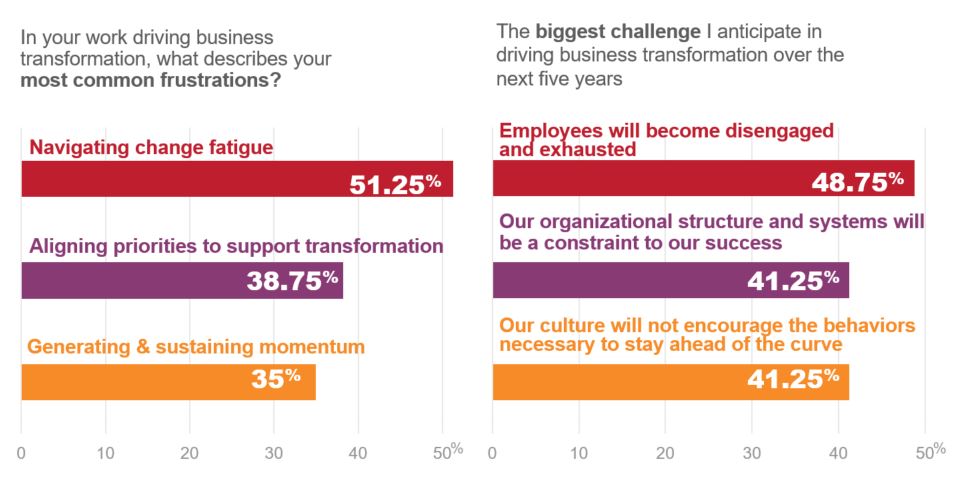Ah, New Year’s resolutions.
We make them every year.
We have every intent of running those miles, cutting those calories, reading that book, taking that course, learning how to crochet…you get the idea.
But, inevitably, most of us end up breaking them.
According to a study conducted by the University of Scranton, just 8% of people achieve their New Year’s goals, while around 80% fail to keep their New Year’s resolutions (New York Post).
According to a study conducted by the University of Scranton, just 8% of people achieve their New Year’s goals, while around 80% fail to keep their New Year’s resolutions. @NYPost Share on XAs they strive to change for the better, businesses face odds that are just as bleak.
According to a KPMG Global Transformation study, 96% of organizations reported they were undergoing business transformations, but only 47% expected to realize sustainable value from those efforts.
In fact, an estimated 70% of change efforts fail outright—often due to employee resistance (McKinsey & Company).
(Humans with an aversion to change? You can’t be serious. ??)
A Customer-Obsessed Culture is All the Rage
Often, New Year’s resolutions are spawned from current trends.
In previous years, I’ve heard friends make declarations like,”I’m going to go Vegan!”
Then, they would run out and buy tons of tofu and veggie cheese, only to find themselves slicing into a juicy steak two months later.
The hunger pangs for good, old fashioned protein were just too great to resist.
When it comes to business transformations, companies tend to find themselves in similar predicaments. It’s all too easy to fall back into a familiar routine.
One of the current business trends at hand? Creating a customer-obsessed culture.
Amazon pitches ‘customer-obsessed’ culture at Ryman https://t.co/k7SVk6ybgr
— Tennessean (@Tennessean) February 7, 2019
Now, don’t get me wrong. The leaders that decide to make these types of positive culture changes have good intentions.
(and, I’m 100% in support of their efforts and a customer-obsessed culture ?)
But, many organizations fail to realize the level of dedication, discipline and hard work it will take to make their initiatives a success.
Fortunately, Customer Service Consultant, Trainer and Author of “The Service Culture Handbook,” Jeff Toister, is here to help, and I’m here to write about it.
We had the opportunity to sit down at #SmallBizCX19. And, not only did we discuss how companies can successfully make the transition into a customer-obsessed culture, but we also spoke about how they can make their well-intentioned improvements effective and permanent.
First up on the agenda, we identify what makes sticking with change (business or personal) so difficult…
So, Why is Sticking With Change So Hard?
Let’s face it. Just like making major life changes, implementing new organizational policies and procedures is tough.
It takes a lot of work.
You’ve got to come up with a strategy, implement that strategy, make adjustments as needed, and then ensure that the finalized plan is adhered to…forever.
Which brings us to the biggest challenge of all…COMMITMENT.

When I asked Jeff Toister about the biggest challenge faced by companies that have decided to take the plunge into the world of customer-obsessed service, his answer was (you guessed it) “commitment.”
“I’ll give you an example of what that looks like for most businesses versus the few that really succeed,” said Toister.
“There is a really nice lake near my house, and this lake has this path around it. It has a lane in each direction for running, jogging, walking, bicycling, etc. Every January, that path is absolutely choked with people,” he explained. “Why? Because it’s the New Year, and ‘This is the year that I’m finally gonna go out and do it! I’ve got my new running shoes, my new outfit, and it’s great!’ So, that’s, I think, a metaphor for businesses that are trying to become customer-focused.”
Toister continued, “But, here’s the difference between the many and the few: Come February…most of those people…90% of those people are gone. They give up. They stopped. It was too much work. It wasn’t that they didn’t know what to do. It was that doing it relentlessly everyday was hard.”
“Here’s the difference between the many and the few: Come February…most of those people…90% of those people are gone. They give up. They stopped. It was too much work. It wasn’t that they didn’t know what to do. It was that doing it relentlessly everyday was hard.”
-Jeff Toister,
Customer Service Consultant & Author
Talk about a tough pill to swallow. But, the fact of the matter is that Jeff is 100% right.
When it’s cold and dark in the middle of winter, I don’t want to go to the gym. I don’t care if I promised myself or the invisible Gods that I would. “Screw it…,” I say. “I’ll go tomorrow.”
Facilitating a major transition in the corporate world is no different.
Leaders, managers, and customer service staff have emails to answer, reports to run, meetings to attend, deadlines to meet, and, in the middle of a particularly stressful week, they think to themselves,”You know what…I don’t have time for this today.”
It’s Not Your Employees. It’s You.
Often, when we fail to keep our New Year’s resolutions, our first instinct is to make an excuse or finger point.
“Ugh. Why did Cindy from accounting have to bring in cupcakes for Bill’s birthday? There goes my diet.”
Sound familiar?
It’s human nature. Similarly, those that lead have no qualms about assuming that their employees will be the ones to hinder forward progress.
For instance, close to 48% of change leaders predict that their biggest challenge will be that their employees will become disengaged and exhausted (Institute for Public Relations).

Source: Institute for Public Relations
So, it’s not surprising that many managers believe that it will be entirely too difficult to get their employees to buy-in to a customer-obsessed culture long-term.
However, employees care about making positive changes more than we realize.
In fact, purpose-oriented employees experience 64% higher levels of fulfillment in their work compared to non-purpose-oriented employees (BluLeadz).
Purpose-oriented employees experience 64% higher levels of fulfillment in their work compared to non-purpose-oriented employees. @Bluleadz Share on X“I think that employees really do care. They care more than we think,” said, Toister. “They don’t care like a business owner would care. So, sometimes that’s misinterpreted as not caring. If I own a small business, I care a lot. That’s my identity. But, employees still care. However, they face a lot of challenges that really diminish their motivation.”
So, we must ask ourselves the question: What are the challenges that employees face when it comes to fully adopting a customer-obsessed culture?
The Barriers that Lie Between Your Brand and a Customer-Obsessed Culture
The roadblocks to a successful implementation of a customer-obsessed culture can be varied and many.
However, after years of hands-on experience in the customer service trenches, Jeff Toister has been kind enough to share his frontline insights with us.
Here are the 3 challenges he has witnessed customer service teams struggle with most frequently.
Challenges Faced by Customer Service Teams during a Customer-Obsessed Culture Initiative:
- The business owner or leadership doesn’t properly articulate their vision.
In order for employees to understand what your brand’s version of a customer-obsessed culture is, you have to show them what your version of customer-obsessed service looks like. Many leaders assume that because they can envision how high-level service should be delivered, that everyone else should be able to see the vision as clearly as they do. However, only 40% of the workforce reports knowing their company’s goals, strategies, and tactics (Bain). So, properly coach your employees and set clear expectations! They’ll work harder because of it. 80% of employees feel more engaged when their work is consistent with the core values and mission of their organization (IBM).80% of employees feel more engaged when their work is consistent with the core values and mission of their organization @IBM Share on X - Employees don’t have the resources that they need to provide great service. Unfortunately, 3 out of 4 employees believe employers don’t give them access to the latest technology to do their job efficiently (Staples). In contrast, those that do provide their staff with up-to-date technology and resources notice a significant difference in performance. More than 85% of employers say employees who have used mobile devices and software specifically designed to train customer-facing employees are better able to meet customer expectations after learning to use such tools (Inkling and Forrester).3 out of 4 employees believe employers don’t give them access to the latest technology to do their job efficiently. @Staples Share on X
- Employees feel like they’re stretched thin or underappreciated. 1 in 5 employees is highly engaged yet still at risk of burnout. Reasons for this include understaffing, heavy workloads, lack of resources, etc. Let’s face it. Every job has it stressors. However, when employees feel recognized and valued, it can make all the difference in the world. Of course, it’s not going to be the magical answer to all of your problems, but showing a little appreciation can go a long way. 70% of employees say that motivation and morale would improve massively with managers saying thank you more (Reward Gateway).70% of employees say that motivation and morale would improve massively with managers saying thank you more. @RewardGateway Share on X
The Steps to a Customer-Obsessed Culture.
Alright.
We’ve spent a good portion of this article talking about failed diets, abandoned running shoes, and how hard it is to make a major change (in life or in business).
I don’t know about you, but I’m ready for some positivity.
Odds aside…what if were possible to commit and actually make a real difference?
Remember the New Year’s resolution statistic that I opened this article with?
Let us not forget about the devoted 8% that actually make it happen. If they can do it, why can’t you?
So, if you want to serve up some of the best customer experiences this world has ever seen, these are the foundational cornerstones that will get you there.
After all, a journey of a thousand miles begins with a single step.
Step 1: Have a Clear Vision.
Can you believe that a whopping 61% of employees don’t know what their company’s mission is? Crazy, right?
And, quite honestly, establishing a vision and communicating that vision is one of the easiest steps a company can take towards putting their business and their customer service team on the right track.
“A vision is simply a shared definition of outstanding service or an outstanding experience that gets everyone on the same page,” explains Toister.
Keep in mind…each company’s definition of a customer-obsessed culture will be unique to their individual brand.
Once you have a clear idea of what your customer-obsessed culture will look like, share your new mission with the entire company.
Even non-customer facing employees should know your vision. In order for a culture initiative to be a success, the entire staff has to be on board.
Shockingly, 86% of corporate executives, employees and educators say that ineffective communication is a top reason for failures in the workplace (Salesforce).
86% of corporate executives, employees and educators say that ineffective communication is a top reason for failures in the workplace. @Salesforce Share on XSo, clear communication of your expectations and mission is key in order for your culture transformation to become a reality.
Step 2: Engage Your Employees.
Once you’ve shared your vision with your staff, you’ve given them the green light to become fully engaged in their work.
When leaders connect their employees to a purpose, they are 373% more likely to have a strong sense of purpose, 747% more likely to be highly engaged, and 49% less likely to burn out (O.C. Tanner).
There’s finally a credible answer for this hotly debated chicken-and-egg problem. What are your thoughts on it? https://t.co/Hb0IQOeN0V #employeeengagement #business #HR
— EAT Club (@eatclub) November 22, 2019
“An engaged employee understands the vision, so they know what makes the organization successful, and they’re committed to helping achieve it. So, if they know, this is what we’re trying to do, and here’s how I can contribute. Then, that employee is by definition engaged,” says Toister.
You’ll also be happy to hear that engaged teams aren’t just good for implementing a customer-obsessed culture.
They’re flat-out, all around good for business. According to Forbes, highly engaged teams show 21% greater profitability.
Step 3: Alignment.
Alignment is the last step, and by far the most important.
It’s also a step that you’ll never have to stop making. Alignment requires continual attention and effort. (Hint: This is where commitment comes in ?)
“The third step is, and this one is critical, we need alignment. In other words, we need to make sure that everything we are doing is aligned with that vision, so it’s easy for employees to provide outstanding service,” explains Toister.
What does it mean to make sure “everything” is aligned?
It means that available resources, the work environment, HR policies, training programs, and incentives should all be conducive to your brand’s vision of a customer-obsessed culture.
Employees’ overall ratings of their company’s qualities — like collaboration, work environment, and mission and value alignment — are 20% higher at companies with strong cultures. These qualities help winning cultures keep employees aligned and motivated (Via CultureIQ).
In Conclusion, You’ve Got to Keep Running
Yes, it’s going to take a lot of effort.
But, all of the blood, sweat and tears will be worth it.
Researchers have found that companies that have the best corporate cultures, encourage all-around leadership initiatives and highly appreciate their employees and customers grew 682% in revenue (Forbes).
Trust us. Your commitment to a customer-obsessed culture initiative is what will make you one of the few successes among many failures.
“That’s what separates the businesses that do it well from the businesses that don’t… If you’re not still relentlessly focusing on service and experience 6 months later and reinforcing those same messages, then it’s going to fade. In fact, most leaders have told me, ‘If I send my people to one class, I might get a week or two of improved performance (like the people at the lake that I see).” But, then we quickly go back to our bad habits. So it’s really the commitment more than anything else that separates the few from the many,” says Toister.
For more business tips and customer service advice like LiveHelpNow on Facebook or follow our business page on LinkedIn.




